![]() Corporate getaway for big and small ...
Corporate getaway for big and small ...
One night free at this this fully-catered retreat in Winelands
| Tuesday to Sunday, 10am to 4.30pm The largest exhibition of bronze statues anywhere in the world. | |
 | 079 879 7880 |
 | Century City |
 | info@longmarchtofreedom.co.za |
 | longmarchtofreedom |
Last updated: Tuesday, 21 January 2025
The Long March to Freedom heritage exhibition, which is the largest of its kind in the world, is a moving journey through 350 years of our struggle history.
The life-size bronze figures are of fearless leaders both here and abroad, from King Shaka (the founder of the Zulu Kingdom) to Fidel Castro (the former president of Cuba) and those who ferociously fought for our democracy – all marching decisively towards our destined future.
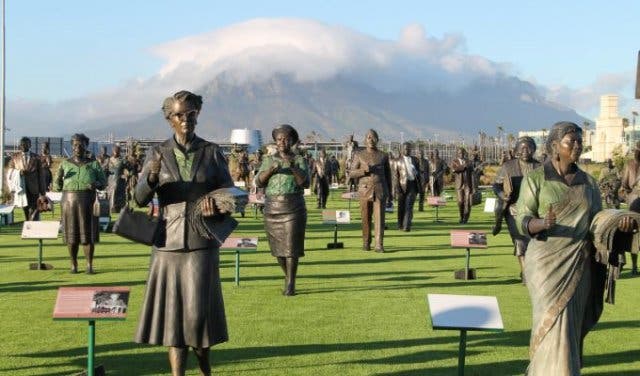
The exhibition spans 350 years of history, starting in the 1900s at the front and moving backward to the 1600s. Image: Long March to Freedom
These are not steely, cold sculptures. The 100 statues capture a lot about the people and the times. Resplendent in their garb, uniforms and suits, they brandish their tools for liberation, from bibles, typewriters and petitions to spears, guns, bicycles and horses.
Their stances, expressions, personal items and treasures, including pets and smoking pipes, tell us about the individuals and their convictions.
We take you face-to-face with the 100 figures in this heritage exhibition.
Chris Hani (1942–1993): He was the loved and respected commander of Umkhonto we Sizwe. His statue shows him holding his finger upwards, representing his deep belief in the cause he fought and died for.
Olive Schreiner (1855–1920): She was a feminist, writer, and social activist whose work highlighted racial inequality and women's rights. Her dog, Rita, who shares her resting place at Buffelskop Mountain in the Eastern Cape, is sculpted beside her.
Olof Palme (1927–1986): The statue of the Swedish prime minister who was a supporter of the South African liberation struggle carries a single rose, which he would buy for his wife every Friday.
Oliver Tambo (1917–1993): Nelson Mandela’s friend and confidant who spent more than 30 years in exile and established South Africa's first black law partnership with Mandela.
Samora Machel (1933–1986): The statue of the founder and first president of Mozambique, and a key ally in South Africa’s anti-apartheid struggle, is dressed in his military commander uniform.
Solomon Mahlangu (1956–1979): The young anti-apartheid activist whose moving last words were, “My blood will nourish the tree that will bear the fruits of freedom. Tell my people that I love them. They must continue the fight,” has both hands raised towards the sky, each showing a peace sign, with a gun in his waist.
Steve Bantu Biko (1946–1977): The leader of the Black Consciousness Movement grips his book, I Write What I Like, which has inspired generations of political thought since it was published in 1978.
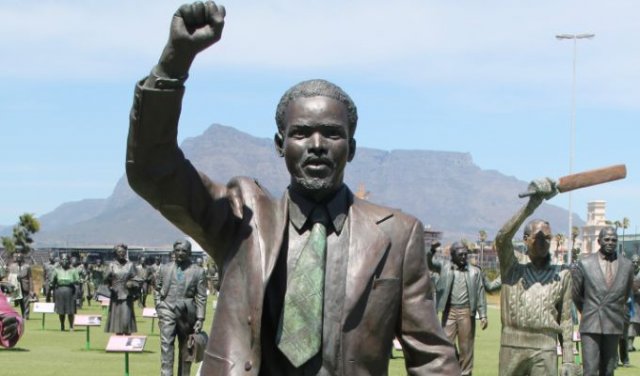
The statue of Steve Bantu Biko. Image: Long March to Freedom
Helen Suzman (1917–2009): The statue of the sole anti-apartheid voice in South Africa’s parliament for years, wears a white shirt and is adorned with a pearl necklace.
Dr Martin Luther King Jr (1929–1968): His philosophy of non-violence and his “I have a dream” influenced the South African liberation struggle and the world. The American civil rights leader’s statue is aptly featured among the 100+ freedom heroes.
Fidel Castro (1926–2016): The president of Cuba, who played a key role in Africa's struggles for liberation and independence in the 1970s and 1980s, waves a Cuban flag up in the air.
Walter Sisulu (1912–2003) and his wife Albertina Sisulu (1918–2011): The stalwarts of the ANC and the struggle have a love story as legendary as the sacrifices they made. Their statues look joyous, holding hands with the others raised in the air.
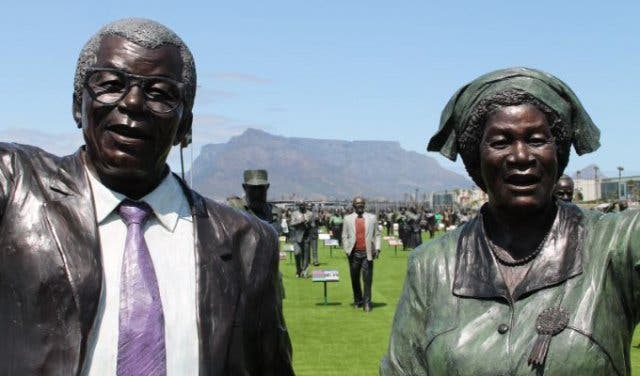
The twin statues of Walter Sisulu and his wife Albertina Sisulu. Image: Long March to Freedom
Miriam Makeba (1932–2008): The statue of the singer who spoke out against apartheid and was one of the first black South Africans to achieve international fame, looks resplendent in her outfit and holds a mic.
Griffiths Mxenge (1935–1981): The anti-apartheid lawyer and activist murdered for his advocacy for detainees and political prisoners, dons a suit and carries a folder.
Ahmed Kathrada (1929–2017): Who was a key figure in the ANC’s underground movement, was imprisoned alongside Nelson Mandela on Robben Island, and while in jail completed a bachelor’s degree in history and criminology.
Haile Selassie (1892–1975): The emperor of Ethiopia and a prominent figure in the Pan-African movement, wears his vibrant military uniform.
Basil D'Oliveira (1928–2011): The South African-born cricketer played for England and became a symbol of the opposition to racial integration in sports. His statue is dressed in his cricket gear.
Dr Beyers Naudé (1915–2004): He’s dressed in a cassock (black robe) and carries a bible. The South African pastor left the Dutch Reformed Church to advocate for racial justice and reconciliation.
Steve Tshwete (1938–2002): The sculpture of one of the key figures in the ANC’s armed struggle and prominent government minister, post-apartheid, holds his hands behind his back.
Bram Fischer (1908–1975): The lawyer and anti-apartheid activist is in a suit and carries a briefcase, as he would have appeared many times while defending Mandela and other anti-apartheid leaders in court.
Professor Kader Asmal (1934–2011): The newest statue of the man who spent 27 years in exile where he created the Irish Anti-Apartheid Movement, was unveiled on 5 December 2024.
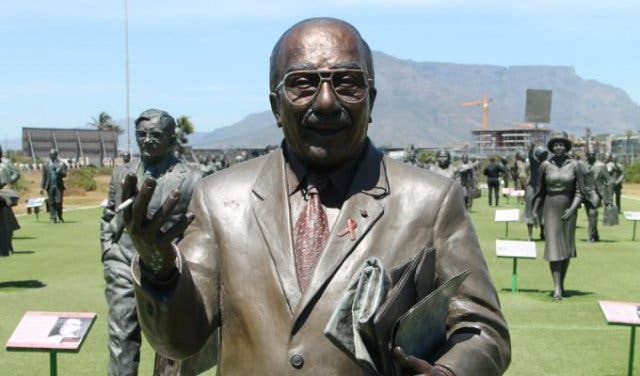
Professor Kader Asmal is the latest figure to be added to the exhibition. Image: Long March to Freedom
Victoria Mxenge (1942–1985): The statue of the anti-apartheid lawyer killed by the apartheid regime, spots her round glasses and a red scarf knotted around her neck.
Julius Nyerere (1922–1999): The first president of Tanzania and a key figure in Pan-Africanism, is dressed in a Mao tunic suit, his preferred attire.
Helen Joseph (1905–1992): She is pictured next to Lilian Ngoyi and Rahima Moosa, the leaders of the 1956 Women’s March against pass laws.
Rahima Moosa (1929–1968): The statue of the prominent member of the ANC Women’s League wears a traditional sari and an exact copy of her long flower earrings.
Josie (Palmer) Mpama (1903–1979): She dedicated her life to the fight against racial injustice. In 2004, she posthumously received the Order of Luthuli in Silver for her lifelong contribution.
King Maqoma (1798–1873): The statue of one of the greatest Xhosa military commanders who played a major part in the Sixth and Eighth Xhosa Frontier Wars, rides a horse.
King Hintsa kaKhawuta (1789–1835): A paramount chief of the Xhosa who was a key figure in the Xhosa Wars and in resistance to colonialism. His statue rides a horse and is placed alongside his cousins, King Maqoma and King Mgolombane Sandile Ngqika.
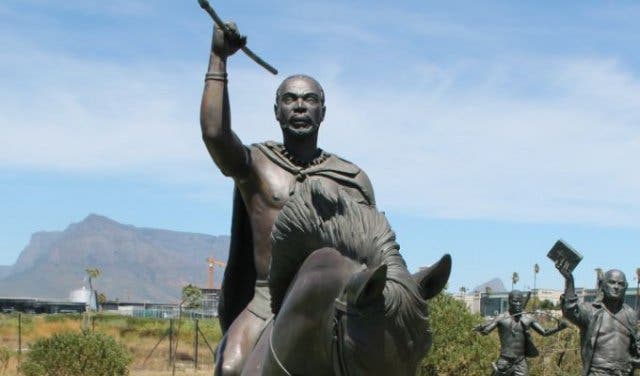
The statue of King Hintsa kaKhawuta. Image: Long March to Freedom
Jack Hodgson (1910–1977): The statue of the British-born activist who mobilised international support against apartheid, carries a blue blazer over his shoulder.
Govan Mbeki (1910–2001): The statue of the man who spent years in exile advocating for African liberation and helped shape the first post-apartheid government, holds the page with the opening lines from his book The Struggle for Liberation in South Africa: A Short History.
Father Trevor Huddleston (1913–1998): The statue of the British Anglican priest whose support for liberation movements made him an iconic figure in the global anti-apartheid campaign, is in the garb he wore as the priest in charge of the Anglican mission at Sophiatown and carries a bible.
Frances Baard (1908–1997): The statue of the anti-apartheid activist and Trade Unionist who organised workers and advocated for racial justice, is adorned in a blue dress.
Dr Abdullah Abdurahman (1872–1940): The Muslim doctor was instrumental in advocating for civil rights and equality for black South Africans. His statue is placed next to his daughter’s, Zainunisa Gool.
Zainunisa "Cissie" Gool (1897–1963): Her figure holds up a sign that reads “segregation is slavery”. She was a social and political activist who worked to empower women and advocated for the rights of the poor in Cape Town.
Bertha Mkhize (1889–1981): The teacher who was deeply involved in organising political and social resistance, particularly among African women, also had a tailoring business. Her statue holds a seamstress tape.
Dorothy Nyembe (1932–1998): The leader of the ANC Women’s League is shown in her uniform, cleaning her glasses, looking straight ahead.
Bertha Gxowa (1934–2010): The feminist activist who played an important role in the development of women’s rights post-apartheid has a hospital in Gauteng named after her.
Ruth Mompati (1925–2015): Her sculpture holds a poster with one of her famous quotes: “It is a very important thing for me to be African. I never forgot that I was a daughter of Africa. It is what saw me through the darkest days of exile.”
Archbishop Emeritus Desmond Tutu (1931–2021): He was a Nobel Peace Prize laureate and outspoken leader who was internationally praised for his fight against the injustices South Africa faced. He is shown in his bright purple robe, welcoming smile and open arms.
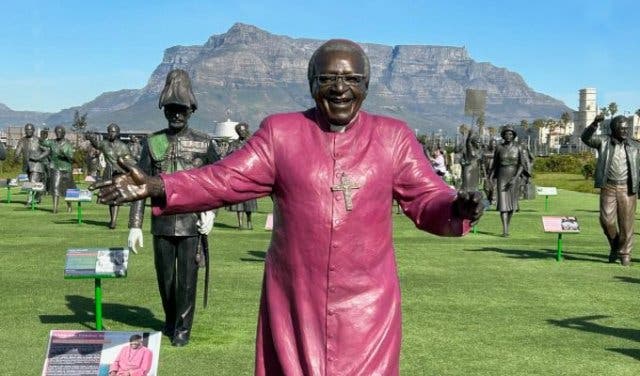
The statue of Archbishop Emeritus Desmond Tutu in his bright purple robe. Image: Long March to Freedom
King Mgolombane Sandile Ngqika (1820–1878): He was the amaRharhabe Xhosa chief who led the Seventh, Eighth and Ninth Frontier Wars against the British. His statue rides a horse to show he is a warrior leader and his head is adorned with feathers.
Annie Silinga (1910–1984): The teacher and member of the ANC Women's League was repeatedly arrested for refusing to carry a pass. Instead of accepting the state pension offered in exchange for her compliance, she chose to live in poverty and died never carrying a pass.
Mohandas "Mahatma" Gandhi (1869–1948): The leader of India’s independence movement who lived in South Africa and contributed to the anti-apartheid struggle. His sculpture carries a pocket watch, one of his few worldly possessions.
Dr Yusaf Dadoo (1909–1983): The statue of the prominent leader of the South African Communist Party holds a smoking pipe.
Dr AB Xuma (1893–1962): His statue carries his lab coat and stethoscope. He was a medical doctor as well as a leading ANC figure who advocated for political, social, and economic change, better education and healthcare reform.
King Nyabêla (1825–1902): The statue of the regent King of the Ndzundza-Ndebele, who fought several wars against the Zuid-Afrikaansche Republiek (ZAR), is barefoot and carries a large shield.
Ray Alexander Simons (1913–2004): A key member of the ANC and South African Communist Party. She helped found the Federation of South African Women and drafted the Women’s Charter, which her sculpture carries.
King Mzilikazi Ka Mashobane Khumalo (1795–1868): The statue of one of the most successful southern African empire-builders, known as the “Maker of the Nation,” is dressed in feathers and a tooth necklace.
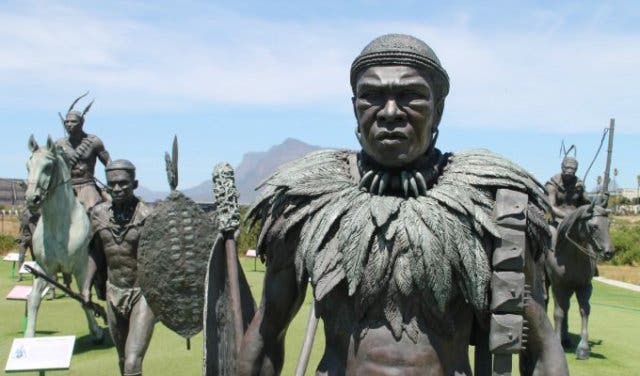
Statue of King Mzilikazi Ka Mashobane Khumalo. Image: Long March to Freedom
Chief Albert Luthuli (1898–1967): He was a Nobel Peace Prize laureate and the president of the ANC. After the Sharpeville Massacre, he called for a national stay-at-home strike to protest the regime's inhumane actions, publicly burning his passbook.
Adelaide Tambo (1929–2007): The figure of the nurse, member of the ANC, and founder of the African-Asian Solidarity Movement wears a yellow robe and doek with beaded necklaces.
King Dingane kaSenzangakhona (1795–1840): He was the second king of the Zulu Kingdom and a significant figure in early conflicts with the British. His statue also carries a small spear, which he copied from his brother, King Shaka.
Zachariah Keodirelang (K) Matthews (1901–1968): The statue of the educator, political leader, activist, and leader of the ANC, shows his hand extended to shake a hand as a gesture of peace and unity.
Duma Nokwe (1927–1978): A prominent lawyer and leading member of the ANC’s legal team who defended activists against apartheid charges.
King Makhado Ramabulana (1825–1895): Known as the Lion of the North, this Venda king was ferocious when resisting attempts to drive him off his land. His statue wears a suit and carries a knife.
Robert Sobukwe (1924–1978): The statue of the founder of the Pan Africanist Congress who was imprisoned on Robben Island, captures a famous pose of his, with his hands behind his back.
Chief Kgamanyane Pilane (1820–1871): His statue is shown riding a bull, reflecting the historical accounts of his people riding cattle. The chief of the Bakgatla led the resistance against colonisation and fought to preserve their heritage and autonomy.
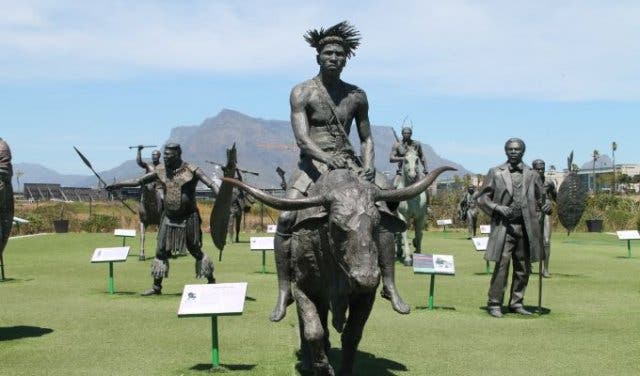
Statue of Chief Kgamanyane Pilane. Image: Long March to Freedom
Anton Muziwakhe Lembede (1914–1947): The statue of the founding president of the ANC Youth League is adorned in a suit with a blue tie.
Bhambatha Kamancinza (c1865–1906): The statue of the leader of the 1906 Zulu rebellion against British colonialism is in traditional Zulu garb and holds a long spear.
Clements Kadalie (1896–1951): The statue of the trade unionist and political leader who played a significant role in organising African workers, dons a bow tie and has a hat in his hand.
King Moshoeshoe I (1786–1870): The Basotho Kingdom founder and one of the most famous 19th-century African leaders who led military action against colonial forces. His statue is in a tall hat, and his outstretched hand is depicted in a gesture of offering a handshake, symbolising peace.
Reverend Zaccheus Mahabane (1881–1971): Like the other clergymen, his statue holds a bible in his hand. Mahabane was a political figure and leader in the African Methodist Episcopal Church.
King Faku (1780–1867): Under his astute leadership, the amaMpondo kingdom was one of the last African kingdoms in South Africa to fall under colonial rule in 1894. His statue wears leopard skin and has a scar on its left cheek.
Sefako Makgatho (1861–1951): His courage inspired Nelson Mandela, who named his second son after him. The politician and activist who served as president of the ANC led a successful campaign in Pretoria for the right to walk on pavements.
Selophe Thema (1886–1955): The statue of the member of the South African Native National Congress and advocate for equal rights, holds a copy of Bantu World, the newspaper he co-founded and edited.
King Langalibalele (1818–1889): The king who was convicted of treason, murder and rebellion in 1874 during, what some consider, South Africa's first treason trial. His sculpture carries a shield, spear and gun.
Alan Paton (1903–1988): The writer and activist whose novel Cry, the Beloved Country helped draw international attention to the anti-apartheid struggle. His sculpture carries a book and pen.
John Dube (1871–1946): He was the first president of the ANC and a pioneering leader in the struggle for African rights in South Africa. His statue holds a folded petition to the prime minister.
Charlotte Maxeke (1871–1939): The statue of the first black South African woman to earn a degree and an advocate for women's rights, carries books, symbolising her deep commitment to education.
Winnie Madikizela-Mandela (1936–2018) and Nelson Mandela (1918–2013): The twin statues hold hands with their other hands raised in the air in a fist in that iconic image seen around the world after his release from prison.
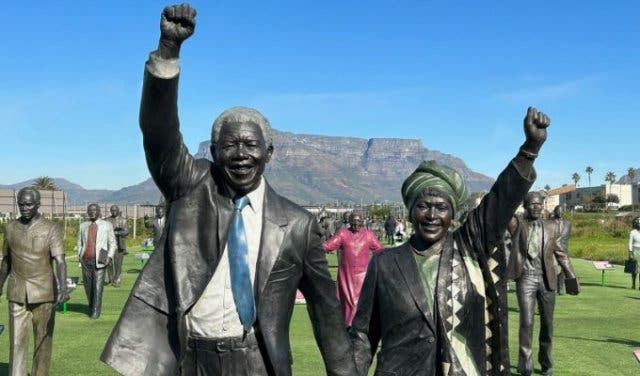
The twin statues of Winnie Madikizela-Mandela and Nelson Mandela holding hands. Image: Long March to Freedom
King Dinuzulu kaCetshwayo (1868–1913): The king of the Zulus and a key figure in that kingdom's resistance to British colonialism. His statue is adorned with beaded necklaces and stands barefoot.
Alfred Mangena (1879–1924): The statue of the founding member of the South African Native National Congress and the first qualified black lawyer, is dressed in a smart suit and red bow tie.
Pixley Ka Isaka Seme (1881–1951): He was one of the founders of the ANC and an advocate for African nationalism in South Africa. His statue holds a stick symbolising strength and authority.
Walter Rubusana (1858–1936): Remembered as one of the leading Africans of his time, in religion, literature, and politics, he also co-founded the Xhosa newspaper Izwi Labantu and was the first black person to be elected to the Cape Council in 1909.
Chief Kgalusi Leboho (Maleboho) (1844–1939): The statue of the Bahananwa chief whose land was invaded after he refused to pay taxes to the Afrikaner government is dressed in a suit, barefoot, as he wanted to feel connected to his ancestors.
Sol Plaatje (1876–1932): The renowned writer and intellectual was the author of Mhudi, the first full-length novel by an African published in English. He was also one of the founding members of the South African Native National Congress. His statue rides a bicycle (which he rode from Eastern Cape to Johannesburg) and carries a typewriter.
Hadji Ojer Ally (1853–1922): The statue of the first chairperson of the Coloured People’s Association, the first Hamidia Islamic Society president, and a close colleague of Mahatma Gandhi, wears a suit and tie and carries a walking stick.
Saul Msane (c1856–1919): A prominent member of the ANC and an active journalist and editor of the ANC newspaper, Abantu-Batho. His sculpture is in a long suit coat and wears a ring on the pinky finger.
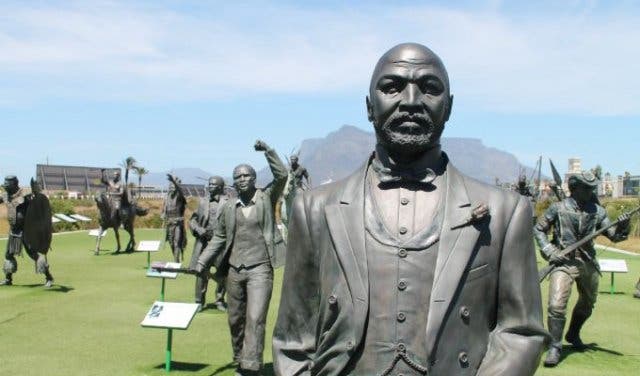
The statue of Saul Msane. Image: Long March to Freedom
Thomas Mtobi Mapikela (1869–1945): A carpenter by trade, he became a founding member and speaker of the South African Native National Congress.
Josiah Gumede (1867–1946): An influential ANC leader who worked to create a political space for black South Africans within the colonial system. His statue holds The Philosophy & Opinions of Marcus Garvey under its arm, reflecting the influence of the Jamaican political activist.
Queen Labotsibeni Mdluli (1838–1923): The Queen Regent of Swaziland whose people called her Gwamile, meaning “The Indomitable One”, for protecting their independence and culture from colonial threats.
King Sekhukhune (1814–1882): The statue of the ruler of BaPedi and a key figure in the resistance to colonisation in southern Africa wears a large tooth necklace.
Chief Tshwana (mid-1700s): The statue of the leader who, according to oral history, inhabited the area now known as Tshwane, was involved in the early resistance against colonisation. He carries a monkey knife which contains poison.
Harriette Emily Colenso (1847–1932): She was known for her harsh criticism of colonial policies and was the first woman to give testimony before the British House of Commons. Her sculpture is placed next to her father’s, Bishop John William Colenso.
Lilian Ngoyi (1911–1980): She was the first woman to be elected to the executive of the ANC. Her figure is in the collared blouse she designed and wore at the 1956 Women's March (which became the official uniform of the ANC Women's League still worn today) and holding some of the 14 000 petitions for apartheid Prime Minister JG Strijdom.
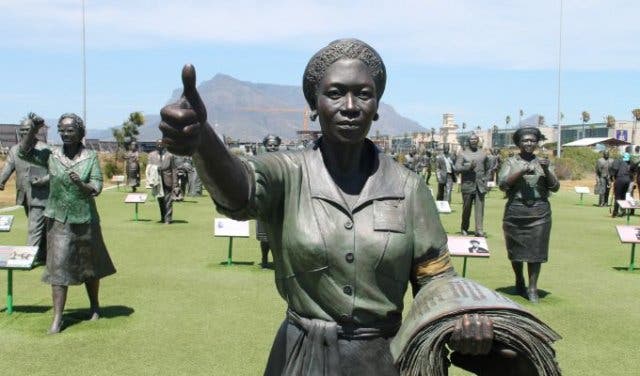
Lilian Ngoyi’s statue holding some of the petitions for apartheid Prime Minister JG Strijdom. Image: Long March to Freedom
Bishop John William Colenso (1814–1883): The first Anglican bishop of Natal who criticised British colonialism and advocated for the rights of indigenous people. His statue holds a bible to highlight his unwavering religious and humanitarian efforts.
King Shaka (1781–1828): The statue of the founder of the Zulu Kingdom and one of the most famous leaders in southern African history, carries a small spear that he broke in half, which made his army more effective in close combat.
Adam Kok III (1811–1875): The chief of the Kok clan of the Griquas established a self-governing territory that raised its own revenue and had its own currency. His sculpture wears a bow tie reflecting his adoption of European dress codes because of his uncertainty about what clothing was appropriate for coloured people.
Dr Johannes van der Kemp (1747–1811): The statue of the first missionary among amaXhosa, whose approach broke tradition by separating his teachings of faith from notions of European civilisation, has his arm raised, holding a bible.
Chief Makana (1780–1820): The leader of the Xhosa people who led an unsuccessful uprising against British colonial forces in the early 19th century. His statue carries a bag of bones to symbolise that he was a traditional healer.
King Cetshwayo kaMpande (1826–1884): He was the last king of the Zulu Kingdom before its conquest by the British and a prominent figure in the Anglo-Zulu War.
Louis van Mauritius (1778–1830): The statue of the Cape Colony leader who fought against colonisation through Khoikhoi resistance movements, wears a British soldier's jacket with Chinese-style pants.

The statue of Louis van Mauritius. Image: Long March to Freedom
Chief David Stuurman (1713–1830): He established land that became a refuge for runaway Khoena (Khoi) farmworkers, slaves and conscripts. His statue wears a cross necklace as he was introduced to Christianity.
Klaas Stuurman (1760–1803): He led the Gamtoos Nation in a coalition for liberation and opposed European attempts to make his people vagrants in their own land. His statue holds a gun, as he was fearless and very skilled with this weapon.
Ida Mntwana (1903–1960): The teacher and activist worked to empower women and children and advocate for equal education. In her statue, she holds her hands up to gesture, “power to the people”.
Autshumato (1625–1663): The statue of the Khoikhoi leader, trader and intermediary between the Khoikhoi and the Dutch, carries a long spear and wears a beaded necklace.
Nommoa (Doman) Goringhaiqua (1618–1663): The statue of the interpreter and activist who advised on military tactics during the First Khoikhoi-Dutch War, holds a spear and has a pipe hanging from his necklace.
Chief Dalasile (1820–1895 ): He resisted British expansion and led his clan against colonial domination during the Qwathi Rebellion of 1880–1881. His statue holds a book and pen as he was known for recording everything, and one foot rests on a stone, in a fighting stance.
Ruth First (1925–1982) and Joe Slovo (1926–1995): Her hand rests gently on his shoulder, while he discreetly carries a gun (once offered to Nelson Mandela) in his pocket. Ruth was assassinated for her fearless exposure of the apartheid regime's crimes. Joe was a prominent leader in the South African Communist Party and ANC's armed wing.
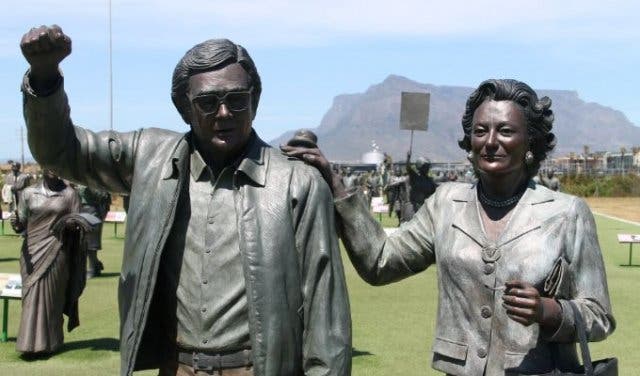
The twin statues of Joe Slovo and Ruth First. Image: Long March to Freedom
You can’t go to Paris without seeing the Eiffel Tower, China without visiting the Great Wall, or New York and miss the Statue of Liberty.
So, too, it is with Cape Town and the Long March to Freedom exhibition, which is a powerful narrative of our freedom told through the people who were at the centre of it through the decades.
Discover more when you read our feature: 10 reasons why Long March to Freedom demands a visit.
Full-price ticket including a guided tour: R75
Subsidised ticket, no tour: R20 (South Africa citizens & residents only)
Guided tours: R75 for international visitors, no tour: R50
Free on-site parking is available when you buy at the coffee shop. There's a covered seating area under a pergola, picnic benches and a tuck shop.
The Long March to Freedom is open: Tuesday to Sunday & public holidays, 10am to 4.30pm
Find it: Long March to Freedom | Century Boulevard | Century City | Cape Town
Cost: R20 – R75
Book: Via Webtickets
Contact on: 079 879 7880, info@longmarchtofreedom.co.za
By Saarah Gierdien
----
Find more free and cheap things to do with kids.
Discover museums in Cape Town.
Check out 7+ things to do this weekend.
---
Loved discovering this? Make sure you get our popular weekly newsletter. Follow and like us on Twitter ❤ Facebook ❤ LinkedIn ❤ Instagram ❤ Pinterest for updates.
![]() Corporate getaway for big and small ...
Corporate getaway for big and small ...
One night free at this this fully-catered retreat in Winelands
![]() The hidden seaside bistro on the ...
The hidden seaside bistro on the ...
Inventive small plates best explored with a wine pairing
![]() Reasons to visit this beach-side family ...
Reasons to visit this beach-side family ...
DIY waffles, loaded hotdogs, poke bowls, right on the beach
![]() Brewery with food specials (almost) ...
Brewery with food specials (almost) ...
Daily specials on comfort meals like burgers and schnitzels
![]() Meet 100 bronze life-size figures at ...
Meet 100 bronze life-size figures at ...
From famous heroes like Mandela to forgotten ones like Autshumato
![]() Get over the midweek hump with a ...
Get over the midweek hump with a ...
Easy spot for team building, midweek date night, & more
![]() Cape Town accommodation special for a ...
Cape Town accommodation special for a ...
20% off, free breakfast, access to rooftop pool
![]() Team building, stylish conferencing & ...
Team building, stylish conferencing & ...
Ultimate work-play-and-stay hub, Trail’s End
![]() Shimansky Diamond Experience at The ...
Shimansky Diamond Experience at The ...
The diamond showroom where you can polish your own stone
![]() Ficks, Hermanus’s tidal pool ...
Ficks, Hermanus’s tidal pool ...
Just as wonderful at night & during the cooler months
![]() The café creating space for ...
The café creating space for ...
It’s hidden in Hermanus. Here’s how to find it